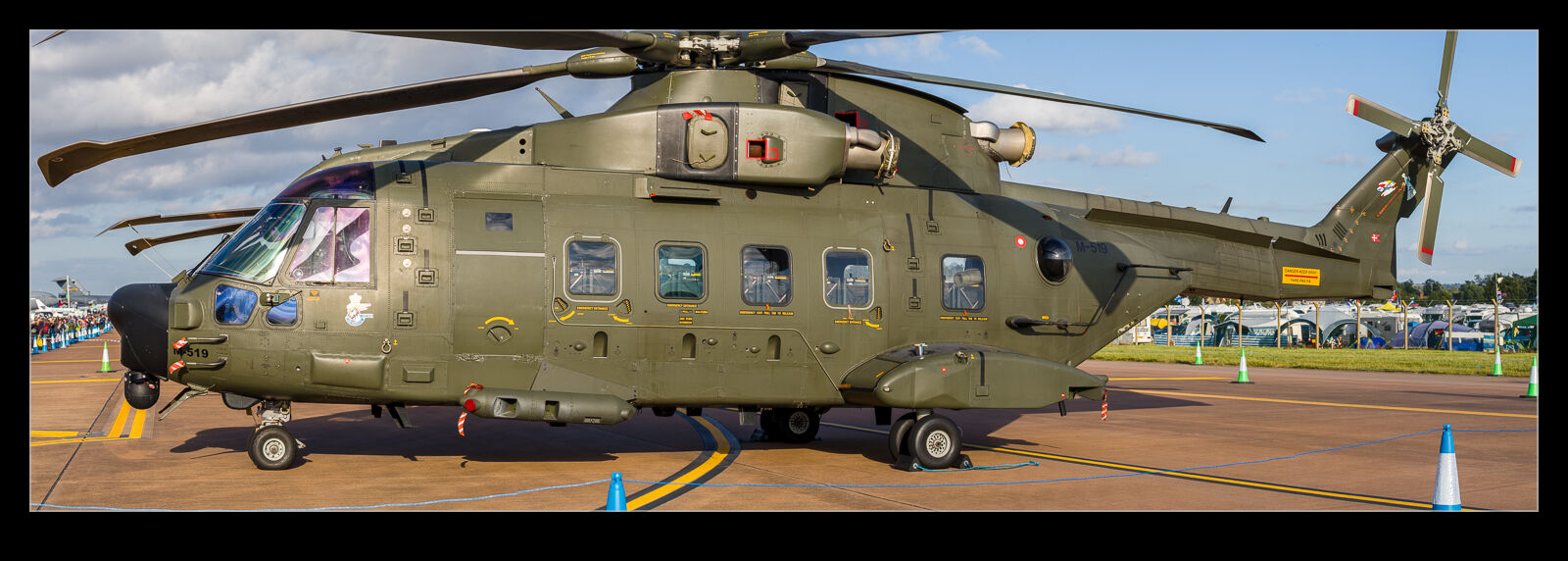

 Lightroom has three methods for stitching the panoramas together. I tend to use one but for some shots, a different style is beneficial. I was flipping through some shots of an HH-101 Caesar helicopter that I took at RIAT in 2019. I also had a Danish AW101 that I had shot in pano format. The Danish airframe had not been shot as well as it could have been and I did not have sufficient coverage. I decided to try different versions of the stitching to see which one gave the best result. Some result in a more natural look while others look more fish eyed. I can also stitch in Photoshop which gives me more capability for filling in gaps but, with the tricky areas being the rotors, that wasn’t going to work well since the AI is not going to work that out. Stitching also allows some warping to fill edge gaps but this can mess with the alignment of the main part of the image. I tried a couple of versions and they are compared here.
Lightroom has three methods for stitching the panoramas together. I tend to use one but for some shots, a different style is beneficial. I was flipping through some shots of an HH-101 Caesar helicopter that I took at RIAT in 2019. I also had a Danish AW101 that I had shot in pano format. The Danish airframe had not been shot as well as it could have been and I did not have sufficient coverage. I decided to try different versions of the stitching to see which one gave the best result. Some result in a more natural look while others look more fish eyed. I can also stitch in Photoshop which gives me more capability for filling in gaps but, with the tricky areas being the rotors, that wasn’t going to work well since the AI is not going to work that out. Stitching also allows some warping to fill edge gaps but this can mess with the alignment of the main part of the image. I tried a couple of versions and they are compared here.
Tag Archives: adobe photoshop lightroom
Speeding Up Lightroom
YouTube is a fantastic way to lose track of time. It may well have an abundance of crap but it also has lots of informative material. More importantly, watch one thing and you get recommendations of other things, many of which are actually quite useful. I was watching a video by Tony Northrup on building a computer for photo processing and he was talking about putting the Lightroom catalog on an SSD. This got me thinking about something.
When I built my system, I installed an SSD to be the drive on which the OS is installed along with the applications. I have traditional hard drives for the data storage. One of these was set up with the Lightroom catalogs keeping them separate from the image files to make the response time better. At the time of the build, a 250Gb SSD was affordable but not cheap so that was what I went with. With everything installed, that doesn’t have enough space for the catalogs.
I never thought more about it until after this video. I started thinking about some old SSDs I have and looked at whether the catalogs would fit on either of them. It turns out that, with all of the preview files, the SSDs were not big enough. However, I did then have a look at the price of a drive that would be large enough such as another 250Gb drive. That would have plenty to spare to account for future needs.
While looking at these, I was also able to see 500Gb drives and they are only about $150. I was unaware just how much the price had fallen. Consequently, a spare drive bay now holds my Lightroom catalogs. I only have a relatively small amount of experience with the new configuration but it is safe to say that things are positively zipping along compared to where they were before. I was wondering whether the system might be in need up upgrade or replacement but this one change seems to have made things significantly better. I will report further if I discover more but, if you have a similar configuration, this might be the upgrade that makes things noticeably better.
